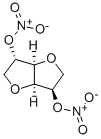THORIUM NITRATE HYDRATE
- CAS NO.:13823-29-5
- Empirical Formula: N4O12Th
- Molecular Weight: 480.06
- MDL number: MFCD00148855
- EINECS: 237-514-1
- SAFETY DATA SHEET (SDS)
- Update Date: 2025-12-03 18:03:33

What is THORIUM NITRATE HYDRATE?
Chemical properties
white solid
The Uses of THORIUM NITRATE HYDRATE
Reagent for determination of fluorine, thoriated tungsten filaments.
General Description
A white crystalline mass. Mildly toxic. Not combustible but accelerates burning of combustible materials. May explode in a fire if in large quantities or if the combustible material is finely divided. Toxic oxides of nitrogen are produced in fires. Mildly radioactive. Radioactive materials emit certain rays detectable only by instruments. Minimal radiation hazard in transport. No protective shielding for packages is required.
Air & Water Reactions
Somewhat soluble in water.
Reactivity Profile
Thorium nitrate is soluble in water and very soluble in alcohol (ethanol) and acids and is not combustible but accelerates burning of combustible materials. Thorium nitrate is highly reactive and incompatible with combustible materials, organic materials, and finely powdered metals. It may explode in a fire if in large quantities or if the combustible material is finely divided. Toxic oxides of nitrogen are produced in fires. Thorium nitrate, on contact with oxidising agent, oxidisable materials, and combustible and/or organic materials, causes fire and chemical hazards and violent explosion.
Mixtures of metal/nonmetal nitrates with alkyl esters may explode, owing to the formation of alkyl nitrates; mixtures a nitrate with phosphorus, tin (II) chloride. or other reducing agents may react explosively [Bretherick 1979 p. 108-109]. With water forms a weak solution of nitric acid, the reaction is not hazardous.
Hazard
Dangerous fire and explosion risk in contact with organic materials, strong oxidizing agent. Radioactive.
Health Hazard
Compound has low chemical toxicity, but alpha emission is expected to constitute a hazard if a fairly large amount is inhaled or ingested. Dust may irritate eyes and cause diffuse dermatitis. Beta and gamma emission is small.
Safety Profile
Poison by intraperitoneal, intravenous, and intratracheal routes. Moderately toxic by ingestion. Experimental reproductive effects. Radioactive. An oxidizing material; when in contact with readily combustible substances will cause violent combustion or ignition. When heated to decomposition it emits toxic fumes of NOx. See also THORIUM and NITRATES.
Properties of THORIUM NITRATE HYDRATE
| Melting point: | decomposes at 500℃ [CRC10] |
| solubility | very soluble in H2O, ethanol |
| color | hygroscopic white plates |
| Water Solubility | g/100g H2O: 186 (0°C), 187 (10°C), 191 (20°C) [LAN05]; additional solubility data are in [SIE94] |
| Merck | 13,9454 |
| Stability: | Stable. Deliquescent. Weakly radioactive (radioactivity 3300 Bq/g). Incompatible with reducing agents. |
| CAS DataBase Reference | 13823-29-5(CAS DataBase Reference) |
| EPA Substance Registry System | Thorium nitrate (13823-29-5) |
Safety information for THORIUM NITRATE HYDRATE
| Signal word | Danger |
| Pictogram(s) |
 Flame Over Circle Oxidizers GHS03  Exclamation Mark Irritant GHS07  Health Hazard GHS08  Environment GHS09 |
| GHS Hazard Statements |
H272:Oxidising liquids;Oxidising solids H302:Acute toxicity,oral H315:Skin corrosion/irritation H319:Serious eye damage/eye irritation H335:Specific target organ toxicity, single exposure;Respiratory tract irritation H373:Specific target organ toxicity, repeated exposure H411:Hazardous to the aquatic environment, long-term hazard |
| Precautionary Statement Codes |
P220:Keep/Store away from clothing/…/combustible materials. P261:Avoid breathing dust/fume/gas/mist/vapours/spray. P273:Avoid release to the environment. P305+P351+P338:IF IN EYES: Rinse cautiously with water for several minutes. Remove contact lenses, if present and easy to do. Continuerinsing. |
Computed Descriptors for THORIUM NITRATE HYDRATE
New Products
Indole Methyl Resin tert-butyl 9-methoxy-3-azaspiro[5.5]undecane-3-carboxylate Boc-His(Boc)-OH 2-CTC Resin 4-Chloro-7-tosy1-7Hpyrrolo[2,3-d]pyrimidine 5,7-Dibromo-1H-indole 2,5-dichloro-N-hydroxy-4,6-dimethylpyridine-3-carboximidamide 2,2-Dimethoxy-7-azaspiro[3.5]nonane hydrochloride 4-chloromethyl-5-methyl-1,3-dioxol-2-one (DMDO-Cl) R-2-BENZYLOXY PROPIONIC ACID 1,1’-CARBONYLDIIMIDAZOLE 1,1’-CARBONYLDI (1,2-4 TRIAZOLE) N-METHYL INDAZOLE-3-CARBOXYLIC ACID 4-((2-hydroxyethyl)thio)benzoic acid 1-(TERT-BUTOXYCARBONYL)-2-PYRROLIDINONE Methyl 6-methylnicotinate 3-Pyridineacrylic acid tert-Butyl carbazate TETRAHYDRO-2H-PYRAN-3-OL 2-((4-morpholinophenylamino) (methylthio) methylene) malononitrile 3-(4-morpholinophenylamino)-5-amino-1H-pyrazole-4-carbonitrile 2,4-dihydroxybenzaldehyde 1,3-Diethyl-1,3-Diphenylurea Methyl 2-methylquinoline-6-carboxylateRelated products of tetrahydrofuran








You may like
-
 Pyridine 99.5% HPLC /UV SpectroscopyView Details
Pyridine 99.5% HPLC /UV SpectroscopyView Details
110-86-1 -
 Guanine , 99%View Details
Guanine , 99%View Details
73-40-5 -
 Piperazine Spot supply, best priceView Details
Piperazine Spot supply, best priceView Details
110-85-0 -
 Potassium Hydroxide 90%View Details
Potassium Hydroxide 90%View Details
1310-58-3 -
 Dibutyl PhthalateView Details
Dibutyl PhthalateView Details
84-74-2 -
 Imidazole Spot supply, competitive priceView Details
Imidazole Spot supply, competitive priceView Details
288-32-4 -
 Octadecyl 3-(3,5-di-tert-butyl-4-hydroxyphenyl)propionate 98% (GC)View Details
Octadecyl 3-(3,5-di-tert-butyl-4-hydroxyphenyl)propionate 98% (GC)View Details
2082-79-3 -
 Thiourea 99% ARView Details
Thiourea 99% ARView Details
62-56-6
